 username@email.com
username@email.com
In this lesson, you will review Mendel’s principles and rules of inheritance, phenotypes and genotypes, pedigrees, genetic diseases, and non-lethal abnormalities.
After Van Leeuwenhoek discovered sperm in 1677, biologists were divided into two warring camps. The “ovists” insisted that it was the egg that carried the traits of the offspring, an adult in miniature. The “spermists” insisted with equal vehemence that the complete future offspring was contained in the animalcule, or the sperm.
And so it went until the mid-nineteenth century yielded the concept of blended inheritance, which suggested that the offspring’s traits arise from a complete blending of all the information in both gametes, or sex cells. In this view, making babies was akin to mixing different color paints—if dad is red and mom is white, the kids will all be pink.
An Austrian monk named Gregor Mendel realized the fallacy in this concept simply by noticing that all offspring were not, in a sense, pink. Traits skipped generations; offspring sometimes seemed to resemble neither parent. These anomalies intrigued Mendel and he used his position as monastery gardener to attempt to figure out what was really going on with inheritance.
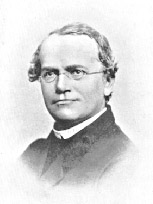
Mendel made the very fortuitous decision to conduct his experiments with common garden peas. He recognized that certain pea varieties seemed to be “pure” for specific characteristics; that is, their offspring always expressed these traits. Furthermore, pea traits were easy to observe. Mendel studied pea plant height (stem length), seed form, seed color, flower color, and other characteristics.
Mendel was not the first to notice or experiment with pea plant traits. He was, however, the first to study them for several generations, to set up a rigorous scientific process to organize his methods and data, to actually count the number of plants with given traits he found in each generation, and, finally, to analyze his results mathematically. Mendel was one of the first scientists to apply mathematical analysis to a biological problem. Therein lies his success.
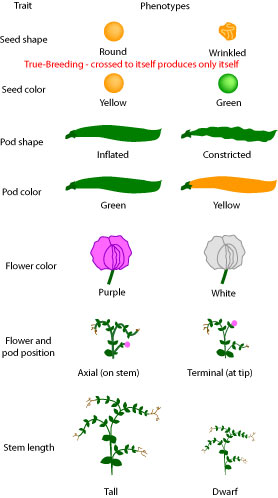
To find out, Mendel let the pea plants self-pollinate to produce the F 2 generation. Voila! The traits absent from F 1 were present in some plants of the F 2 generation. Mendel understood that for these traits to appear in F 2, they must have been present in F 1, even if they were not expressed, or observable. Mendel called these traits recessive.
Mendel determined that the ratio of dominant-to-recessive traits in F 2 was approximately 3:1, and this ratio held constant over generations. Mendel’s great insight was that each trait is caused by what he called “factors” (what we now call genes). These factors had to occur in pairs, one from each parent, for traits to appear, disappear, and reappear over generations. Mendel’s principle of segregation states that every organism contains a pair of factors for each trait and that the pairs segregate into single-factor units during the formation of gametes.
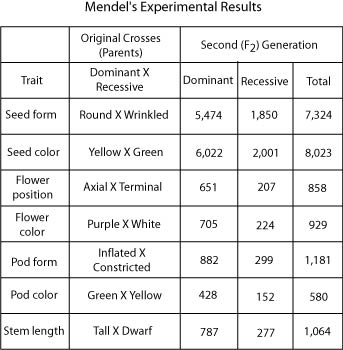
The alleles an individual carries are part of the individual’s
The correct choice is B. An individual’s genotype describes its entire genetic makeup, including all its alleles. Phenotype refers to those traits that are physically expressed and visible in the individual. As not all alleles are visibly expressed, choice A is not correct. Gametes are sex cells, so choice C is incorrect. Alleles are made up of DNA; they are not a part of it, so choice D is not correct.
Which of the following indicates an individual that is heterozygous for two traits?
The correct choice is C. This individual carries both dominant (A, B) and recessive (a, b) alleles for each trait. Choice A is incorrect because this individual carries pairs of identical dominant alleles for each trait. Choice B is not correct because this genotype indicates that the individual is homozygous (BB) for one trait. Choice D is incorrect because this individual, too, is homozygous recessive (aa) for one trait.
Mendel did another set of experiments to look at two traits in cross-bred pea plants. For example, in his first experiments Mendel noted that some plants had green, wrinkled seeds—both recessive traits. But the F 2 generation also produced plants whose phenotype was totally unlike either parent; for example, offspring with smooth, yellow seeds. Mendel wanted to find out where these odd combinations of traits originated.
A Punnett Square allows you to sort and visualize the distribution of alleles in any cross. Capital letters indicate dominance. Lowercase letters indicate recessive alleles.
The P 1 (Parent) generation has the trait smooth seed allele (S) or wrinkled seed allele (s). The alleles segregate and recombine during gamete formation. So offspring would have one of the following allele combinations for this trait.

Then, in the second generation (F 2), some heterozygous individuals would be crossed. The Punnett Square for this cross is:

Mendel crossed a pure-bred dominant strain (round, yellow seeds) with a pure recessive strain (wrinkled, green seeds). In the F 1 generation, all the seeds were round and yellow because the dominant trait was expressed. In the F 2 generation, Mendel’s results were quite different, though he had predicted them. Mendel used mathematical probability to determine that if his “factors” (alleles) sorted independently of one another, they should be expressed in the phenotype of offspring in a ratio of 9:3:3:1. The 9 represents the number of F 2 offspring expressing the two dominant traits in its phenotype. The 1 represents the proportion of offspring that express the recessive phenotype (having two alleles for the recessive form of the trait). The two 3s represent individuals that show combinations of recessive and dominant traits in their phenotype. (This ratio holds for crosses in which both parents are homozygous—one for dominant traits and the other for recessive traits.) From these results, Mendel formulated his second law. The law of independent assortment states that the parts of each pair of genes are distributed independently when gametes are formed. Today, we can restate this to say that if an individual is heterozygous for traits that occur at two unlinked loci on chromosomes, each locus will sort independently of the other.
In F 1, Mendel crossed pea plants that were homozygous dominant for smooth (SS), yellow (YY) seeds with plants that were homozygous recessive for green (ss), wrinkled (yy) seeds.
The first cross was: SSYY x ssyy → all SsYy. The F 1 generation all expressed the dominant genes (all were smooth and yellow).


The ratio is 9:3:3:1, just as Mendel predicted.
The Punnett Square below shows the sorting of alleles that determine hair color, with B indicating dominant brown hair and b indicating recessive red hair. What is the probability that an offspring of this cross will have red hair?

The correct choice is A. All of the offspring display a heterozygous (Bb) genotype. Because of the presence of the dominant trait, brown hair (B), all of the offspring will have the phenotype of brown hair..
A pedigree is a chart that shows which members of several generations of individuals carries a particular gene in its genotype. A pedigree chart can be created to track any trait, though it is most often used to trace the inheritance of genes that cause or might cause disease in a family.
In most pedigree charts, a square indicates a male and a circle indicates a female. A shape that is not shaded indicates that the individual is not a carrier of a gene and does not suffer from a genetic disease. A shape with a dot in it often indicates a carrier of a particular gene. The pop-up below shows a pedigree chart of the occurrence of hemophilia in the royal family of Great Britain. Hemophilia is a sex-linked recessive condition; that is, the gene that causes hemophilia is passed on from mothers to sons, and the appearance of the condition may skip a generation. Hemophilia is a condition in which bleeding cannot be controlled and injury may lead to death. It does not affect the female carrier but can be fatal to sons who inherit the gene. Other sex-linked conditions include color blindness and male-pattern baldness.
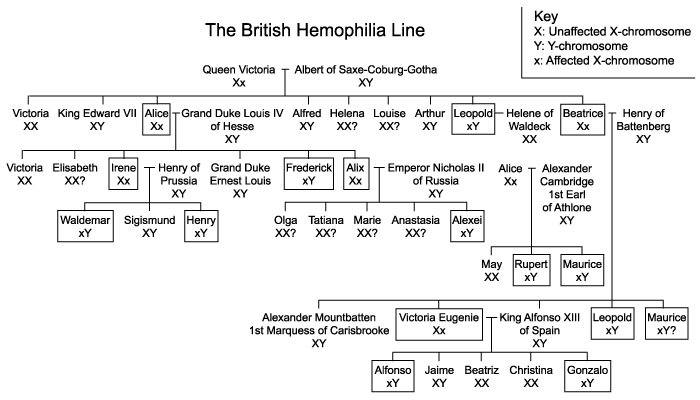
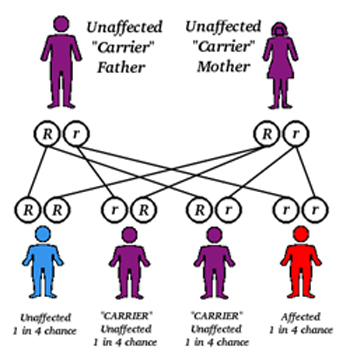
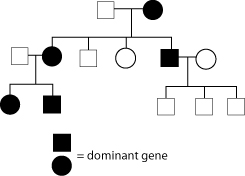
A pedigree chart is helpful for which medical reason?

The correct choice is D. Pedigree charts allow you to track the carriers of a gene in their genotype and those offspring who express the gene in their phenotype. Genealogy does not track the presence or absence of genes, so choice A is not correct. Choice B is incorrect because a pedigree chart cannot help you predict the genotype of future offspring unless you know the genotype of future mates. Choice C is incorrect because just tracing the cause of death may not involve the inheritance of genes.
Genetic diseases that are caused by alleles on the sex chromosomes (X and Y) are called sex-linked diseases. Genetic diseases that are caused by alleles on any other, non-sex chromosome, are called autosomal diseases. Autosomal genetic diseases may be either recessive or dominant, and follow the patterns shown in the previous pedigrees.
Autosomal diseases may be caused by deletions, insertions, or transpositions of nucleotides in a particular gene sequence. For example, cystic fibrosis results from a deletion of a nucleotide sequence in one particular allele. However, because cystic fibrosis is an autosomal recessive disease, affected offspring must inherit the defective allele from both parents.
Sickle-cell anemia is another autosomal recessive disease caused by a mutation in one locus (a point mutation) on human chromosome 11. Only offspring who are homozygous for this mutated allele will suffer from sickle-cell anemia, a disease that results in abnormally shaped (sickle-shape) red blood cells.
One non-lethal autosomal recessive condition is phenylketonuria (PKU). This rare genetic disease affects liver metabolism. In a normal liver, the liver enzyme phenylalanine hydroxylase (PAH) oxidizes the PKU in foods to form the amino acid tyrosine. The creation of tyrosine leads to the normal production of other necessary substances, such as catecholamines and hormones. In PKU, a genetic defect results in lack of or incomplete metabolism of PAH by the liver. Thus, PKU builds up in the blood and other tissues of the body and may cause mental retardation, delayed speech, and even seizures. A strict diet low in foods containing PKU is often sufficient to control this condition.
Genetic diseases that are caused by dominant alleles are far less common, for obvious reasons. If all you need is a single allele to be born with a genetic disease, it is likely that those affected by this disease will not reproduce and pass on the gene. So dominant-allele conditions tend to weed themselves out of the gene pool.
A sex-linked condition is

The correct choice is B. A sex-linked condition, such as hemophilia, is passed from mothers to sons. Choice A is incorrect because a sex-linked condition does not refer to the offspring’s reproductive system, but to genetic inheritance. Choice C is not correct because a sex-linked condition comes from a mother’s genes, not a father’s. Choice D is not correct because a sex-linked condition does not affect the number of sex chromosomes in offspring.
An offspring will suffer from an autosomal recessive condition only if

The correct choice is C. An offspring must have two copies of the recessive gene for it to be expressed—for the condition to appear. If the condition is caused by autosomal recessive genes, then a dominant gene would ensure that the recessive cause of the condition was not expressed, so choice A is not correct. If an offspring is heterozygous for the genes that cause the condition, the offspring has one dominant and one recessive gene for the condition. Thus, the dominant gene would ensure that the disease was not expressed, so choice B is incorrect. Choice D is incorrect because an offspring inherits only one allele from its mother.